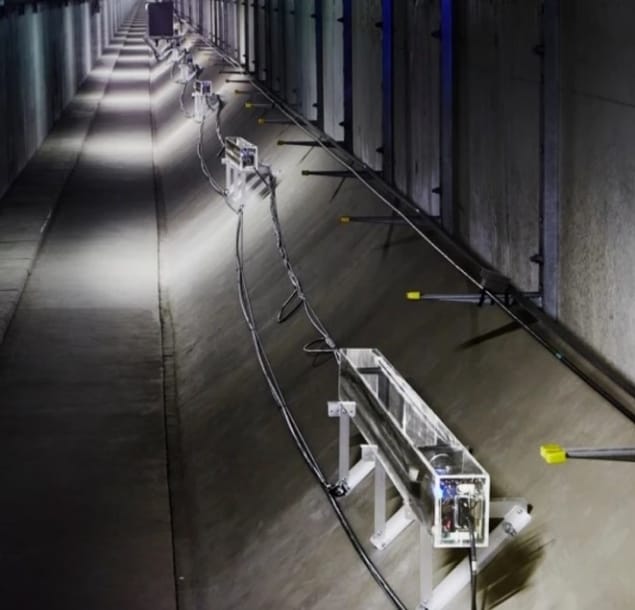
An array of undersea muon detectors that monitors variations in water depth has been created by an international team of researchers. The system comprises a line of sensors that were installed in a road tunnel beneath Tokyo Bay by Hiroyuki Tanaka at the University of Tokyo and colleagues. They used the system to measure how a distant typhoon caused the water level in the bay to oscillate over timescales of several hours. Installing similar detectors worldwide could boost our understanding of weather-related oscillations in the levels of bays and lakes.
High-energy cosmic muons are constantly raining down on Earth and they can travel tens or even hundreds of metres through liquids and solids. However, muons are absorbed by matter and if a muon detector is placed underwater, the number of muons detected will decrease as the depth of water above the detector increases.
In their study, Tanaka’s team explored how muons could be used to study meteotsunamis. These are tsunami-like oscillations in bodies of water that are caused by meteorological effects such as storms, weather fronts and atmospheric gravity waves. Typically, they occur within smaller water bodies such as bays and lakes. The mechanisms that generate meteotsunamis and cause them to propagate are poorly understood.
Expensive to monitor
Depending on local conditions, meteotsunamis can take place over timescales ranging from minutes to several hours. Oscillations can be monitored using tide gauges, buoys and satellites – but these can be costly to build and operate, difficult to access, and do not always provide accurate, real-time measurements.
To create a new way of monitoring water levels, Tanaka’s team placed a line of muon detectors along 200 m of the 9.6 km tunnel portion of the Tokyo Bay Aqua-Line. Called the Tokyo-Bay Seafloor Hyper-Kilometric Submarine Deep Detector (TS-HKMSDD), the array detects cosmic muons that have passed through the water above.

Muons: probing the depths of nuclear waste
Using this setup, the researchers measured variations in the number of muons reaching the sensors during a meteotsunami that struck Tokyo Bay in 2021. This was triggered by a typhoon passing 400 km away. During the event, the number of muons picked up by the detectors revealed variations in water levels associated with the meteotsunami oscillation. The team’s observations closely matched those made by conventional measurement methods.
Based on their success, they now hope that their low-cost, easily accessible muon sensors can be installed in other tunnels. Possible sites include the Transbay Tube beneath San Francisco Bay and the Channel Tunnel, which connects the UK to France.
The research is described in Scientific Reports.



